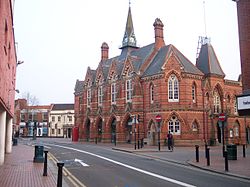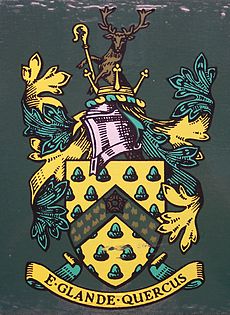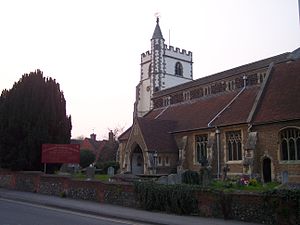Wokingham: Difference between revisions
mNo edit summary |
No edit summary |
||
| Line 16: | Line 16: | ||
| website=[http://www.wokingham-tc.gov.uk/ Wokingham Town Council] | | website=[http://www.wokingham-tc.gov.uk/ Wokingham Town Council] | ||
}} | }} | ||
'''Wokingham''' is a small market town in [[Berkshire]]. It is | '''Wokingham''' is a small market town in [[Berkshire]]. It is seven miles east of [[Reading, Berkshire|Reading]] and 3½ miles west of [[Bracknell]]. | ||
The town's formerly important industry, brick-making, has given way to software development (like much of eastern Berkshire), light engineering and service industries. In 2007 Halifax Estate Agents ranked Wokingham as the number one place to live in the United Kingdom.<ref>[http://news.bbc.co.uk/1/hi/england/7045651.stm ''Wokingham the 'best' city to live''] BBC news online, 17 October 2007</ref> | The town's formerly important industry, brick-making, has given way to software development (like much of eastern Berkshire), light engineering and service industries. In 2007 Halifax Estate Agents ranked Wokingham as the number one place to live in the United Kingdom.<ref>[http://news.bbc.co.uk/1/hi/england/7045651.stm ''Wokingham the 'best' city to live''] BBC news online, 17 October 2007</ref> | ||
| Line 23: | Line 23: | ||
Much of Wokingham has been developed over the past 80 years. Woosehill and Dowlesgreen were built on farmland in the late 1960s and early 70s, along with Bean Oak. Keephatch was built in the early 90s. The Norreys Estate was built in the 1960s; however, Norreys Avenue is the oldest residential road in that area, having been built in the late 1940s as emergency housing following the Second World War. Norreys Avenue has a horseshoe shape and occupies the site of the demolished Norreys Manor. Much of the road contains 1940s-style prefabricated houses, although there are some brick houses along with three blocks of 1950s police houses. | Much of Wokingham has been developed over the past 80 years. Woosehill and Dowlesgreen were built on farmland in the late 1960s and early 70s, along with Bean Oak. Keephatch was built in the early 90s. The Norreys Estate was built in the 1960s; however, Norreys Avenue is the oldest residential road in that area, having been built in the late 1940s as emergency housing following the Second World War. Norreys Avenue has a horseshoe shape and occupies the site of the demolished Norreys Manor. Much of the road contains 1940s-style prefabricated houses, although there are some brick houses along with three blocks of 1950s police houses. | ||
The northern part of the parish of Wokingham is part of a detached part of [[Wiltshire]], some 30 miles to the west, though deemed by the Counties (Detached Parts) Act 1844 thereafter to be part of Berkshire. | The northern part of the parish of Wokingham is part of a detached part of [[Wiltshire]], a county some 30 miles to the west, though deemed by the Counties (Detached Parts) Act 1844 thereafter to be part of Berkshire. | ||
==History== | ==History== | ||
Revision as of 16:52, 23 August 2014
| Wokingham | |
| Berkshire | |
|---|---|
 Wokingham Town Hall | |
| Location | |
| Grid reference: | SU804685 |
| Location: | 51°24’36"N, -0°50’24"W |
| Data | |
| Population: | 30,403 (2001) |
| Post town: | Wokingham |
| Postcode: | RG40, RG41 |
| Dialling code: | 0118 |
| Local Government | |
| Council: | Wokingham |
| Parliamentary constituency: |
Wokingham |
| Website: | Wokingham Town Council |
Wokingham is a small market town in Berkshire. It is seven miles east of Reading and 3½ miles west of Bracknell.
The town's formerly important industry, brick-making, has given way to software development (like much of eastern Berkshire), light engineering and service industries. In 2007 Halifax Estate Agents ranked Wokingham as the number one place to live in the United Kingdom.[1] Wokingham is on the Emm Brook in the Loddon Valley in central Berkshire. It sits between Reading and Bracknell and was originally in a band of agricultural land on the western edge of Windsor Forest. Wokingham currently consists of the town centre, with main residential areas radiating in all directions. These include Woosehill to the west, Emmbrook to the northwest, Dowlesgreen, Norreys, Keephatch and Bean Oak to the east and to the south Wescott and Eastheath.
Much of Wokingham has been developed over the past 80 years. Woosehill and Dowlesgreen were built on farmland in the late 1960s and early 70s, along with Bean Oak. Keephatch was built in the early 90s. The Norreys Estate was built in the 1960s; however, Norreys Avenue is the oldest residential road in that area, having been built in the late 1940s as emergency housing following the Second World War. Norreys Avenue has a horseshoe shape and occupies the site of the demolished Norreys Manor. Much of the road contains 1940s-style prefabricated houses, although there are some brick houses along with three blocks of 1950s police houses.
The northern part of the parish of Wokingham is part of a detached part of Wiltshire, a county some 30 miles to the west, though deemed by the Counties (Detached Parts) Act 1844 thereafter to be part of Berkshire.
History

Wokingham means 'Wocca's people's home'. Wocca was apparently a Saxon chieftain (whose kin may also have owned lands at Wokefield in Berkshire and Woking in Surrey). In Victorian times the town was known as Oakingham and the acorn with oak leaves is the town's symbol.
The courts of Windsor Forest were held at Wokingham and the town had the right to hold a market from 1219. The Bishop of Salisbury was largely responsible for the growth of the town during this period. He set out roads and plots making them available for rent. There are records showing that in 1258 he bought the rights to hold three town fairs every year.[2] Queen Elizabeth I granted a town charter in 1583. From the 14th to the 16th centuries, Wokingham was well-known for its bell foundry which supplied many churches across the south of England.
Wokingham was once famous for its bull-baiting. In 1661 George Staverton left a bequest in his will giving two bulls to be tethered in the Market Place and baited by dogs on St Thomas' Day (21 December) each year. The bulls were paraded around the town a day or two before the event and then locked in the yard of the original Rose Inn which was situated on the site of the present-day Superdrug store. People travelled from miles around to see the dangerous spectacle. A number of dogs would be maimed or killed during the event and the bulls were eventually destroyed. The meat and leather were distributed amongst the poor people of the town. Some of the spectators also sustained fatal injuries. In 1794 on the morning after the bull-baiting Elizabeth North was found dead and covered with bruises. In 1808 55-year-old Martha May died after being hurt by fighters in the crowd. The cruel 'sport' was prohibited by the Corporation in 1821 but bulls were still provided at Christmas and the meat distributed to the poor. Bull-baiting was banned by Act of Parliament in 1833.
In the years of 1634-1644 Wokingham was regularly raided by both the Cavaliers and Roundheads, the two forces in the English Civil War. These raids would involve the looting of livestock and trading goods and general civil unrest. Over thirty buildings were burnt down, accounting for nearly 20% of the towns buildings.[2] It was not until the early 18th Century that Wokingham had fully recovered.
In 1723, the 'Black Act' was passed in Parliament to make it an offence to black one's face to commit criminal acts. It was named after an infamous band of ruffians, known as the 'Wokingham Blacks' who terrorised the local area.
Churches

- Church of England:
- All Saints' Church, transformed from a chapel-of-ease of Sonning in 1190
- St. Paul's Church, built by John Walter III in 1864
- Church at the White House School
- Baptist: Wokingham Baptist Church
- Methodist: Wokingham Methodist Church
- Independent Protestant:
- Roman Catholic: Corpus Christi
Manors
- Evendon's Manor
- Ashridge Manor (now in Hurst, Berkshire)
- Beche's Manor (burnt down 1953)
- Keep Hatch (Built 1871-4, demolished late 1990s due to dereliction to make way for the Keephatch housing estate)
- Buckhurst Manor (now St. Anne's Manor)
- Norreys' Manor
Further reading
- Goatley, K. Wokingham: The Town of my Life. Reading: Conservatree Print and Design, 2004. ISBN 0-9534735-9-7.
- The Wokingham Society. Wokingham: A Chronology, 1978.
- Wyatt, B. Wokingham in Old Photographs. Stroud, Gloucestershire: Budding Books, 1999. ISBN 1-84015-128-5.
- Harison, J. Living Heritage - 300 years of bells, ringing and bellringers at All Saints Wokingham, 2009. ISBN 0-9563740-0-4.
References
- ↑ Wokingham the 'best' city to live BBC news online, 17 October 2007
- ↑ 2.0 2.1 http://visitwokingham.com/history.html